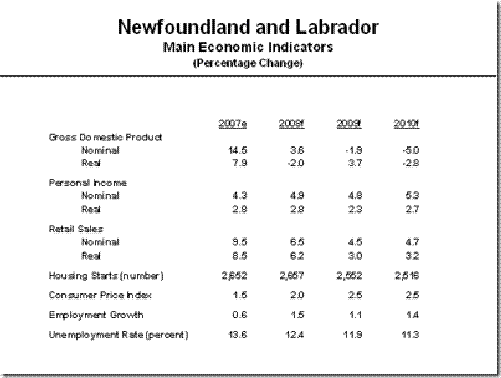According to the Conference Board of Canada’s latest economic projections for the provinces, province’s that are down this year are going up next year.
All except one.
Newfoundland and Labrador’s economy is forecast to shrink 3.6% this year but the Board has now said that the local economy will also contract another half percent in 2010. The Board doesn’t anticipate a return to growth in Newfoundland and Labrador until 2011.
It put Newfoundland and Labrador in a category of its own. That province is expected to post the biggest GDP decline this year at 3.6% and is the only provincial economy forecast by the Conference Board to contract (by 0.5%) in 2010. The board said the province was hurt by declines in forestry, mining and manufacturing this year, and offshore oil drilling is expected to remain at depressed levels next year.
Incidentally, VOCM missed the importance of that entirely.
The forecast contraction for Newfoundland and Labrador this year is the largest in the country for 2009, incidentally.
Now all of that make as a complete mockery of the line coming from local politicians. After the collapse last year, the Premier talked about the province being protected by an economic bubble last year. That turned out to be a version of the St. John’s Harbour bubble apparently.
And just within the past couple of weeks, environment minister Charlene Johnson was out telling a local Rotary Club audience about how the province was well positioned to weather the economic storm due to the wonderful things done by the crowd she’s a part of.
Well that’s another issue.
There’s no question however, the economic bubble was entirely fictitious.
The Conference Board projection is in line with the actual oil revenue data for the first half of 2009 that Bond Papers brought you exclusively earlier this week. it shows royalties are down 57% for the same period in 2008 and that they are 15% below the government’s own forecast thus far.
Oil production is also down. In the first six months of fiscal 2009, production is running about 29% below the same period in 2008.
Add to that personal income tax. Last year, personal income tax (PIT) generated $899,460, 000 in government revenue. That works out to $4, 037 for each of the 220, 300 people working in the province, full-time and part-time. You can find those figures using information in the provincial government’s own financial documents tabled with the budget last spring.
Government lowballed the number for its 2009 budget, projecting PIT at $786 million. That’s despite expected growth in income - yes, they forecast more income going around - and a decline in employment of only 2,000. That $786 million is about $100 million below what the government’s own numbers would work out to be, incidentally. That’s why the ones actually published in the Estimates are said to be low-balled.
Job losses are currently running higher than forecast. In October it was 5,400 for the same month in 2008. Now word publicly on wages but working with the provincial government’s figures and the actual performance you would bring personal income tax in at around $870 million. (4037 X 215,000) Now that’s a rough estimate.
Even if PIT went to the same number as last year by some quirk, it still wouldn’t offset the forecast decline in oil revenues and the drop that came in mining and the forestry sector.
The government is on track to get the budget they forecast. There won’t be any surprises, like discovering that despite all the posturing and puffing about being a have province, the government actually opted to switch formulas and collect Equalization in 2008. They did that, incidentally, five months after Danny Williams made his great “have province” speech at the November Tory fundraiser. It was a spectacular poll goose but it was also a fraud since the provincial government knew the numbers and cabinet knew that it would not make its Equalization election until the following March. There is more to being a have province than a political speech, a poll goose and a rip-off video.
But that, too is another issue.
There are serious issues to be faced in the months ahead. The people of Newfoundland and Labrador are only just now starting to see the signs.
-srbp-



